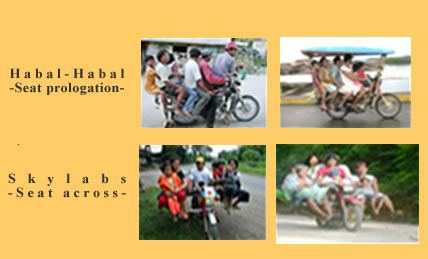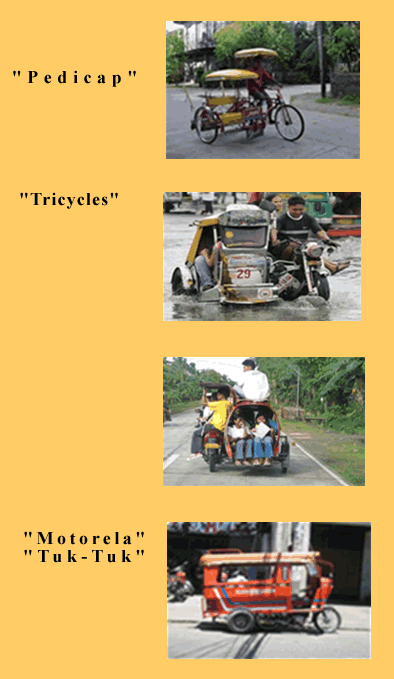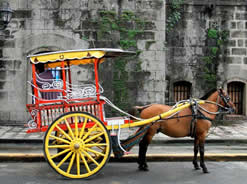Two- and three-wheeled vehicles
It is not of course surprising that there is also growing motorization in the Philippines. The number of the motor vehicles registered by private individuals has increased by about 60 per cent to 5.9 million there in the time period 2000 - 2008. Now approximately every seventh Pinoy has a motor vehicle. From a western perspective it could be expected that the number of the cars would have increased fundamentally. However, thats not right. The number of the cars has increased only by a meagre four per cent. Two- and three-wheeled motorized vehicles are number one with regard to the rate of increase. In 2000, these vehicles recorded only about 0.7 million. However, in 2008 the number tripled to 2.4 million (1). These means of transport are now characterizing the street scene. Each visitor to the Philippines travelling in the province or moving in the suburbs of larger towns can see them. Whether he goes with them or not, is a question of necessity and sometimes also of courage. Let us first have a look on the two-wheeled motorized vehicles which are used for the transport of passengers.
Two-wheeled vehicles
Often a cavalry of self-important habal-habal drivers are waiting under the shadow of trees for passengers. To ride a habal-habal may be pleasant at lower speed and good road conditions. And indeed very often the co-drivers look happy when riding. They seem to have a funny ride. However, the situation becomes delicate when the road becomes bendy, bumpy or muddy. The balance is also endangered, when you still have to hold a bag of rice or other food in your hand. In consideration of these situations it is understandable that some co-drivers have crossed themselves at the start of the journey. It is also advisable to check if the driver does not feel as descendant of racing driver Michael Schumacher and if the cycle has a light at night. Some westerners need if at all a longer time and faith in God, before they take a habal-habal. The second type of motorized two-wheeled vehicle is called Skylab ", probably in analogy to the solar sails of the American space station. Here the seat board is attached across to the driver's seat. Types of this vehicle can be found in particular in hilly regions. They also are used for the timber transport. Skylabs need special balancing skills. Sometimes it is becoming a problem to get out of the way when the road is very narrow and gives place only for one vehicle. The two normally only poorly motorized vehicles are undoubtedly accident-prone and the Republic Act 4136 does in principle not allow the (commercial) use of these vehicles. Often they have explicitly no permission to cycle in cities and highways. In Makati more than 300 law breakers have been arrested and sentenced to fines ands confiscations in 2009. At the same time, the administration asked the population not to use such transportation vehicles even if they allow a faster getting ahead in traffic jams (2). Regulations are in the Philippines often only Theory. Even the persons responsible in the Land Transportation Office (LTO) know that the ban regulations do not correspond to the needs of the population especially in rural areas, which have no good road infrastructure and public transport system. Sometimes the LTO shows also tolerance being convinced that habal-habals and skylabs are indispensable on short weakly developed hauls. The motorcycles are relatively inexpensive, situational and can give additional earnings. Therefore at present some legislative considerations are made to modify the Republic Act 4136 and to allow the habal-habal transport under limited restrictions. Discussed are for instance regional limitations, obliged protective goggles for the driver, limitation of the number of transported persons, safety helmets for drivers and con-drivers, safeguarding handles and a transportation ban for children younger than seven years. Commercial operators should be more controlled with regard to the obligatory licenses and insurances. Tricycles
There are round about 2.8 million Tricycles in the Philippines. They outnumber each other form of public traffic and each tourist will see them it is unavoidably (3). Tricycles are motorcycles with an assembled passenger cabin and a third wheel. Usually the motorcycles are of Japanese provenance (Kawasaki, Honda, Suzuki) and the weak motorized engines of the tricycles range normally from 50cc up to about 125cc. Universal motors which originally were intended for pumps and generators are also in use. The design of tricycles - which are also belonging to the national symbols of the Philippines knows a superabundance of variations. If the tricycle has a roof tall persons should take care that they do not pump with their head to the roof. Two to six persons can find place in the more or less upholstered cabin. Often the following configuration can be found, two opposite rows of seats with a storage capacity for the baggage in the middle. The classical jeepney often serves reference for further decoration. You could see for example a Mercedes star at the front of cabin and inside perhaps a little sampaguita bunch, a rosary, pictures of Maria and other Saints as well as quotations of the Bible. Tricycles have sometimes a mind of their own with regard to steering and beginners should take it into account. Also because of their sheer number tricycles are considered as major pollutants in street traffic and there is the bad rumor that the drivers do not know any traffic regulation. More probable is the assertion that the drivers hold back the traffic by their decreased speed. While tricycles can be found are more often in Manila and Luzon, Motorelas are more numerous in Visaya and the south of the country. Drive unit is here also a motorcycle. In the back part a metal framework with an oversized cabin is assembled. The Tuc-Tucs, which can be seen frequently in Thailand, are smaller and they have only has three wheels, while Motorelas have all together four wheels (4). They have a seat capacity of up to six persons. Sometimes a loudspeaker is installed and the radio is turned up to full volume and nearly everybody seems to enjoy it.
Are these vehicles of transport too shabby and too much subclass for you? You dont want to be crammed like sardines? Are you looking for a cushioned vehicle, which emphasizes your owed importance and gives you the opportunity to greet graciously the people on the street? Then another two-wheeler is perhaps the solution. It is the Calesa or hackney cap. In case that you have enough time and cash, we recommend the route Intramuros to the city of Vigan back and forth. The distance is only round about 410 kilometers. However, dont forget to give your work horse some water. In Vigan, you can change horse and coach. Bon voyage.
© Wolfgang Bethge, 2010 (1) Romulo Virola, Land shipment to The Philippines: Retrogressing Towards Motorcycles? http://www.nscb.gov.ph/headlines/StatsSpeak/2009/101209_rav_raab_trans.asp (2) Alison Lopez, Makati cracks down on motorcycles for-hire, Filipino Daily Inquirer, 11-18-2009 (3) Jeanette Andrade, Finally a tricycle we could love, in: http://newsinfo.inquirer.net/inquirerheadlines/nation/view/20080120-113528/Finally-a-tricycle-we-could-all-love (4) A motorela has regularly four wheels; so the title of our article is not fully correct. |

 At first we have to mention the not motorized Pedicaps (Trisikads"), which are moved by physical strength (by pedes)They are bicycles with assembled sidecars and a third wheel. The equipment of the sidecar varies and depends on the tendency for decoration and the finances of the owner. Mostly, they do dispose two not very comfortable passenger seats. Sometimes a canopy offers protection against rain and hot sun. Pedicaps are frequently used on short stretches of 1-2 kilometers, for example from the road to the house. The price for transport is a question of negotiation. The situation can get embarrassing when a still juvenile, slim driver has to move in the sweat of his brow one or two corpulent tourists with in the heat of midday heat up on a steep slope.
At first we have to mention the not motorized Pedicaps (Trisikads"), which are moved by physical strength (by pedes)They are bicycles with assembled sidecars and a third wheel. The equipment of the sidecar varies and depends on the tendency for decoration and the finances of the owner. Mostly, they do dispose two not very comfortable passenger seats. Sometimes a canopy offers protection against rain and hot sun. Pedicaps are frequently used on short stretches of 1-2 kilometers, for example from the road to the house. The price for transport is a question of negotiation. The situation can get embarrassing when a still juvenile, slim driver has to move in the sweat of his brow one or two corpulent tourists with in the heat of midday heat up on a steep slope. 